Fallout From This Accident Has Already Led to New FAA
Procedures
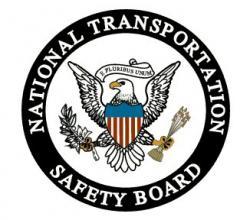 The NTSB has issued an updated report on the
January 8 crash of a Beech 1900, at Charlotte (NC):
The NTSB has issued an updated report on the
January 8 crash of a Beech 1900, at Charlotte (NC):
The National Transportation Safety Board has released the
following updated information on its investigation of the crash of
Air Midwest flight 5481 (d.b.a. US Airways Express) a Beech 1900
(N233YV). The plane, carrying 2 crewmembers and 19 passengers,
crashed shortly after takeoff on January 8, 2003, from
Charlotte-Douglas International Airport, Charlotte, North Carolina.
The following is a summary of factual information of investigative
activities released thus far. Impact forces and fire destroyed the
aircraft; there were no survivors.
Flight Data Recorder
The FDR is a solid state recorder that provides 22 parameters of
data. The data indicate that after maintenance to the aircraft on
January 6, 2003, nine flights occurred before the accident flight.
Information from the load manifests for flights before and after
the maintenance have been obtained.
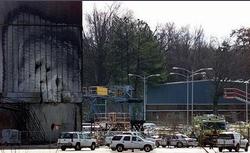 The FDR data show approximately a 10-degree down
shift, as measured by the pitch control position sensor, on all
flights after the maintenance including the accident flight. For
the airplane to cruise at altitude, as it did on the nine flights
after the maintenance, the elevator would have had to be near zero,
but the pitch control position sensor indicated about 10 degrees
down. Regarding the accident flight, pitch control position
movement was recorded during the rotation for takeoff. A
full-nose-down pitch control indication was recorded during the
climb, and movement in the nose-up direction was recorded during
the descent to the ground.
The FDR data show approximately a 10-degree down
shift, as measured by the pitch control position sensor, on all
flights after the maintenance including the accident flight. For
the airplane to cruise at altitude, as it did on the nine flights
after the maintenance, the elevator would have had to be near zero,
but the pitch control position sensor indicated about 10 degrees
down. Regarding the accident flight, pitch control position
movement was recorded during the rotation for takeoff. A
full-nose-down pitch control indication was recorded during the
climb, and movement in the nose-up direction was recorded during
the descent to the ground.
Investigators found that the sensor that indicates pitch control
position was installed when the airplane was built. The sensor is
mounted underneath the cockpit floor and is linked to the control
column with a fixed control rod. In addition, a sensor to indicate
elevator trim position was retrofitted on the airplane in February
2001. That sensor is located in the
wing box and measures movement of the elevator trim tab cable. Both
sensors and connecting linkages have been recovered and preliminary
examination does not reveal evidence of a jam.
Cockpit Voice Recorder
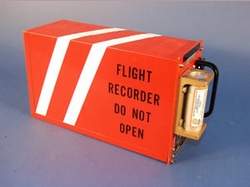 The
CVR provides 30 minutes of audio information. All conversations
regarding the airplane's ground operation, taxi, takeoff roll, and
accident sequence were recorded. A discussion between the pilots
regarding aircraft loading was captured. A transcript
of the recording will be released at a later date.
The
CVR provides 30 minutes of audio information. All conversations
regarding the airplane's ground operation, taxi, takeoff roll, and
accident sequence were recorded. A discussion between the pilots
regarding aircraft loading was captured. A transcript
of the recording will be released at a later date.
Operations Group
The Operation Group determined that the accident crew flew this
airplane on 6 of the 9 flights since the January 6, 2003
maintenance. Interviews of the other flight crews who had flown the
accident aircraft following the maintenance were conducted. The
pilots indicated no problems with the flight controls. Also,
interviews were conducted with the gate and ramp agents who worked
the accident airplane, and witnesses to the accident, and flight
crews who had flown with the accident captain and accident first
officer.
Systems Group
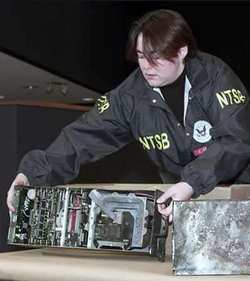 The Systems Group has retained from the wreckage
the elevator control system cables, elevator control rods, bell
cranks, and elevator counter balance weights. Examination of the
elevator control cables revealed that the turnbuckle on the "down"
elevator cable was offset to nearly full extension and the
turnbuckle on the "up" elevator cable was near the fully retracted
position, a difference of 1.8 inches. The turnbuckles are used to
set cable tension and are typically adjusted to about the same
length.
The Systems Group has retained from the wreckage
the elevator control system cables, elevator control rods, bell
cranks, and elevator counter balance weights. Examination of the
elevator control cables revealed that the turnbuckle on the "down"
elevator cable was offset to nearly full extension and the
turnbuckle on the "up" elevator cable was near the fully retracted
position, a difference of 1.8 inches. The turnbuckles are used to
set cable tension and are typically adjusted to about the same
length.
The Systems Group, along with the Maintenance Records Group and
a representative from the FDR Group, completed several ground tests
in Wichita, Kansas, last week. The ground tests included a series
of control column sweeps to collect data on the movement of the
elevator. Various cable tensions and turnbuckle lengths were used
during tests. Investigators are reviewing the results.
Other Activities
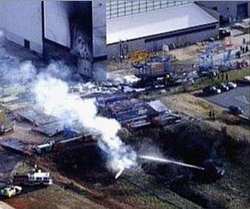 The Structures Group retained the cargo hooks from
the wreckage to look for identifiable witness marks that will help
determine if the hooks were attached at the time of the crash. The
Powerplants Group plans to begin the teardown of the engines this
week. The inspection of the propellers is tentatively
scheduled for next month. The aircraft Performance Group is
gathering information for use in its engineering simulation of the
accident flight and previous flights.
The Structures Group retained the cargo hooks from
the wreckage to look for identifiable witness marks that will help
determine if the hooks were attached at the time of the crash. The
Powerplants Group plans to begin the teardown of the engines this
week. The inspection of the propellers is tentatively
scheduled for next month. The aircraft Performance Group is
gathering information for use in its engineering simulation of the
accident flight and previous flights.
 Aero-News: Quote of the Day (12.18.25)
Aero-News: Quote of the Day (12.18.25) Classic Aero-TV: Viking Twin Otter 400--Bringing the DHC-6 Back Into Production
Classic Aero-TV: Viking Twin Otter 400--Bringing the DHC-6 Back Into Production NTSB Final Report: Rans Employee Flying Club Rans S-6ES Coyote II
NTSB Final Report: Rans Employee Flying Club Rans S-6ES Coyote II ANN FAQ: Submit a News Story!
ANN FAQ: Submit a News Story! ANN's Daily Aero-Term (12.18.25): Braking Action Advisories
ANN's Daily Aero-Term (12.18.25): Braking Action Advisories







